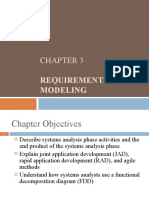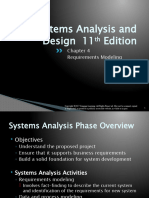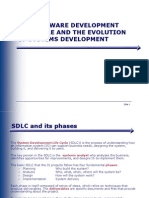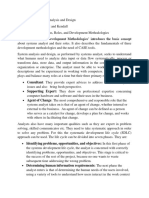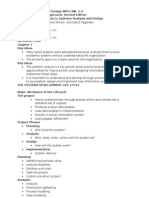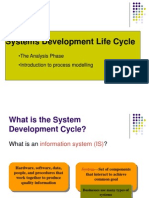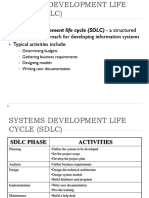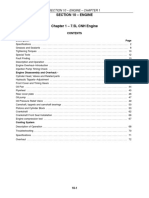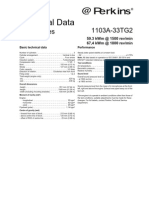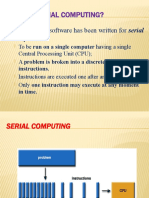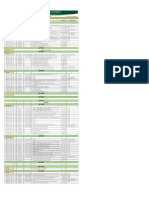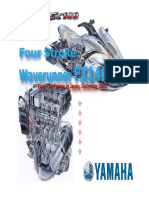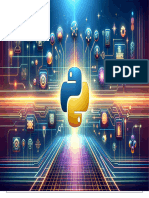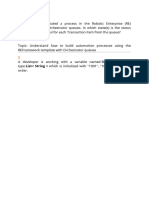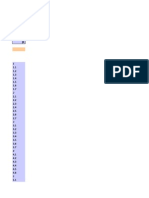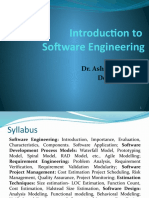02/10/2023
systems analysis phase
To understand the proposed project, ensure that it will support business requirements,
and build a solid foundation for system development, by using models and other
documentation tools to visualize and describe the proposed system.
Systems Analysis and Design, 11th Edition
Scott Tilley and Harry Rosenblatt
1
� 02/10/2023
• Systems analysis is the second of five
phases in the systems development
life cycle (SDLC)
• Will use requirements modeling, data
and process modeling, and object
modeling techniques to represent the
new system
• Will consider various development
strategies for the new system, and
plan for the transition to systems
design tasks
3
The Challenge
in understanding
system requirements
2
� 02/10/2023
Chapter Objectives
Describe systems analysis phase activities and the end product of the
systems analysis phase
Explain Joint Application Development (JAD), Rapid Application
Development (RAD), and Agile methods
Understand how systems analysts use a Functional Decomposition Diagram
(FDD)
Describe the Unified Modeling Language (UML) and explain use case
diagrams and sequence diagrams
List and describe system requirements, including outputs, inputs,
processes, performance, and controls
Explain the concept of scalability
Chapter Objectives
Use fact-finding techniques, including interviews, documentation review,
observation, questionnaires, sampling, and research
Define total cost of ownership (TCO)
Conduct a successful interview
Develop effective documentation methods to use during systems
development
3
� 02/10/2023
Introduction
• This chapter describes requirements modeling techniques and team-based
methods that systems analysts use to visualize and document new systems
• The chapter then discusses system requirements and fact-finding
techniques, which include interviewing, documentation review,
observation, surveys and questionnaires, sampling, and research
Systems Analysis Phase Overview
Interaction among the three
modeling tasks:
requirements modeling,
data and process
modeling,
and object modeling
4
� 02/10/2023
Systems Analysis Phase Overview
Requirements modeling
describes requirements modeling, which involves fact-finding to describe
the current system and identification of the requirements for the new
system, such as:
Output refers to electronic or printed information produced by the
system.
Input refers to necessary data that enters the system, either manually or
in an automated manner.
Process refers to the logical rules that are applied to transform the data
into meaningful information.
Performance refers to system characteristics, such as speed, volume,
capacity, availability, and reliability.
Security refers to hardware, software, and procedural controls that
safeguard and protect the system and its data from internal or external
threats.
9
Systems Analysis Phase Overview
Data and process modeling
modeling process by showing how to represent graphically system data
and processes using traditional structured analysis techniques.
As described in Chapter 1, structured analysis identifies the data
flowing into a process, the business rules that transform the data, and
the resulting output data flow.
Object Modeling
structured analysis treats processes and data as separate components,
object-oriented (O-O) analysis combines data and the processes that
act on the data into things called objects.
These objects represent actual people, things, transactions, and events
that affect the system.
During the system development process, analysts often use both modeling
methods to gain as much information as possible.
10
5
� 02/10/2023
Systems Analysis Phase Overview
Development Strategies
There various development options within the transition of the systems
design phase of the SDLC.
As described in Chapter 1, structured analysis identifies the data
flowing into a process, the business rules that transform the data, and
the resulting output data flow.
11
Systems Analysis Phase Overview
Systems Analysis Skills
Analytical skills
Interpersonal skills
Team-Oriented Methods and Techniques
Joint application development (JAD)
Rapid application development (RAD)
Agile methods
12
6
� 02/10/2023
Joint Application Development
(JAD)
User Involvement
Users have a vital stake in an information system and they should
participate fully
Successful systems must be user-oriented, and users need to be
involved
One popular strategy for user involvement is a JAD team approach
13
Joint Application Development
(JAD)
JAD Participants and Roles
14
7
� 02/10/2023
Joint Application Development
(JAD)
JAD Advantages and Disadvantages
More expensive and can be cumbersome if the group is too large
relative to the size of the project
Allows key users to participate effectively
When properly used, JAD can result in a more accurate statement of
system requirements, a better understanding of common goals, and a
stronger commitment to the success of the new system
15
Rapid Application Development
(RAD)
The RAD model
consists of four
phases.
16
8
� 02/10/2023
Rapid Application Development
(RAD)
RAD Objectives
To cut development time and expense by involving the users in every
phase of systems development
Successful RAD team must have IT resources, skills, and management
support
Helps a development team design a system that requires a highly
interactive or complex user interface
17
Rapid Application Development
(RAD)
RAD Advantages and Disadvantages
Systems can be developed more quickly with significant cost savings
RAD stresses the mechanics of the system itself and does not
emphasize the company’s strategic business needs
Might allow less time to develop quality, consistency, and design
standards
18
9
� 02/10/2023
Agile Methods
Attempt to develop a system incrementally
Agilian modeling toolset includes support for many modeling tools
Some agile developers prefer not to use CASE tools at all, and rely
instead on whiteboard displays and arrangements of movable sticky
notes.
This approach, they believe, reinforces the agile strategy: simple, rapid,
flexible, and user-oriented.
19
Agile Methods
Scrum is another agile approach. The name comes from the rugby term
scrum, where team members lunge at each other to achieve their
objectives, as shown in Figure 4-7.
The systems development version of Scrum involves the same intense
interaction, though it is more mental than physical. In a Scrum session,
agile team members play specific roles.
20
10
� 02/10/2023
Agile Methods
Agile Method Advantages and Disadvantages
Are very flexible and efficient in dealing with change
Frequent deliverables constantly validate the project and reduce risk
Team members need a high level of technical and interpersonal skills
May be subject to significant change in scope
21
Modeling Tools and Techniques
Functional Decomposition Diagrams (FDD)
A functional decomposition diagram (FDD) is a top-down representation of
a function or process.
Using an FDD, an analyst can show business functions and break them
down into lower-level functions and processes.
Creating an FDD is similar to drawing an organization chart: Start at the top
and work downwards.
FDDs can be used at several stages of systems development. During
requirements modeling, analysts use FDDs to model business functions
and show how they are organized into lower-level processes.
Those processes translate into program modules during application
development.
22
11
� 02/10/2023
Modeling Tools and Techniques
Functional Decomposition Diagrams (FDD)
23
Modeling Tools and Techniques
Functional Decomposition Diagram (FDD)
24
12
� 02/10/2023
Esukan boking system
Esukan
ADMIN USER
MANAGE MANAGE MANAGE OWN MANAGE
MANAGE ACC REPORT EQUIPMENT
EQUIPMENT BOOKING ACC BOOKING
ADD ACC ADD ADD ADD VIEW ADD
VIEW ACC VIEW VIEW VIEW REQUEST VIEW
EDIT /
EDIT ACC EDIT CHANGE EDIT EDIT
STATUS
DELETE ACC DELETE DELETE DELETE DELETE
25
26
13
� 02/10/2023
Modeling Tools and Techniques
Data Flow Diagrams (DFD)
Working from a functional decomposition diagram, analysts can create
data flow diagrams (DFDs) to show how the system stores, processes, and
transforms data.
27
Modeling Tools and Techniques
Unified Modeling Language (UML)
widely used method of
visualizing and documenting
software systems design. UML
uses object-oriented design
concepts, but it is independent
of any specific programming
language and can be used to
describe business processes and
requirements generally.
UML provides various graphical
tools, such as use case diagrams
and sequence diagrams.
28
14
� 02/10/2023
System Requirements Checklist
During requirements modeling, systems developers must identify and
describe all system requirements.
A system requirement is a characteristic or feature that must be included in
an information system to satisfy business requirements and be acceptable
to users.
System requirements serve as benchmarks to measure the overall
acceptability of the finished system.
System requirements fall into five general categories: outputs, inputs,
processes, performance, and controls.
29
System Requirements Checklist
Outputs Examples
The Web site must report online volume statistics every four hours, and
hourly during peak periods
The inventory system must produce a daily report showing the part
number, description, quantity on hand, quantity allocated, quantity
available, and unit cost of all sorted by part number
Inputs Examples
Manufacturing employees must swipe their ID cards into online data
collection terminals that record labor costs and calculate production
efficiency
The department head must enter overtime hours on a separate screen
30
15
� 02/10/2023
System Requirements Checklist
Processes Examples
The student records system must calculate the GPA at the end of each
semester
As the final step in year-end processing, the payroll system must update
employee salaries, bonuses, and benefits and produce tax data required by
the IRS
Performance Examples
The system must support 25 users online simultaneously
Response time must not exceed four seconds
Controls Examples
The system must provide logon security at the operating system level and
at the application level
An employee record must be added, changed, or deleted only by a member
of the human resources department
31
Future Growth, Costs, and Benefits
In addition to the system requirements, systems analysts must consider
scalability, which determines how a system will handle future growth and
demands, and the total cost of ownership, which includes all future
operational and support costs.
Scalability
A scalable system offers a better return on the initial investment
To evaluate scalability, you need information about projected future
volume for all outputs, inputs, and processes
32
16
� 02/10/2023
Future Growth, Costs, and Benefits
• Total Cost of Ownership
– Total cost of ownership
(TCO) is especially important
if the development team is
evaluating several
alternatives
– One problem is that cost
estimates tend to
understate indirect costs
– Rapid Economic Justification
(REJ)
33
Future Growth, Costs, and Benefits
• Total Cost of Ownership
– Because cost control is so
important, vendors often claim
that their products or services will
reduce TCO significantly.
– For example, one of the most
common reasons to migrate a
legacy system to the cloud is
reduced TCO. As shown in Figure
4-15, cloud computing offers the
opportunity for lower operational
costs due to the outsourcing of
expenses such as capital
investment in exchange for a pay-
as-you-go pricing model.
34
17
� 02/10/2023
Fact-Finding
Fact-Finding Overview
First, you must identify the information you need
Develop a fact-finding plan
Who, What, Where, When, How, and Why?
Difference between asking what is being done and what could or
should be done
35
Fact-Finding
The Zachman Framework
Zachman Framework for
Enterprise Architecture
Helps managers and
users understand the
model and assures that
overall business goals
translate into successful
IT projects
36
18
� 02/10/2023
Interviews
Step 1: Determine the People to Interview
Informal structures
Step 2: Establish Objectives for the
Interview
Determine the general areas to be
discussed
List the facts you want to gather
37
Interviews
Step 3: Develop Interview Questions
Creating a standard list of interview questions helps to keep you on
track and avoid unnecessary tangents
Avoid leading questions
Open-ended questions
Closed-ended questions
Range-of-response questions
38
19
� 02/10/2023
Interviews
Step 4: Prepare for the Interview
Careful preparation is essential because an interview is an important
meeting and not just a casual chat
Limit the interview to no more than one hour
Send a list of topics
Ask the interviewee to have samples available
39
Interviews
Step 5: Conduct the Interview
Develop a specific plan for the meeting
Begin by introducing yourself, describing the project, and explaining
your interview objectives
Engaged listening
Allow the person enough time to think about the question
After an interview, you should summarize the session and seek a
confirmation
40
20
� 02/10/2023
Interviews
• Step 6: Document the Interview
– Note taking should be kept to a minimum
– After conducting the interview, you must record the information
quickly
– After the interview, send memo to the interviewee expressing your
appreciation
– Note date, time, location, purpose of the interview, and the main
points you discussed so the interviewee has a written summary and can
offer additions or corrections
41
Interviews
Step 7: Evaluate the Interview
In addition to recording the facts obtained in an interview, try to
identify any possible biases
Unsuccessful Interviews
No matter how well you prepare for interviews, some are not
successful
42
21
� 02/10/2023
Other Fact-Finding Techniques
• Document Review
• Observation
– Seeing the system in action gives
you additional perspective and a
better understanding of the
system procedures
– Plan your observations in advance
– Hawthorne Effect
43
Other Fact-Finding Techniques
Questionnaires and Surveys
When designing a
questionnaire, the most
important rule of all is to
make sure that your
questions collect the right
data in a form that you
can use to further your
fact-finding
Fill-in form
44
22
� 02/10/2023
Other Fact-Finding Techniques
Sampling
Systematic sample
Stratified sample
Random sample
Main objective of a sample is to ensure that it represents the overall
population accurately
45
Other Fact-Finding Techniques
Research
Can include the Internet,
IT magazines, and books
to obtain background
information, technical
material, and news about
industry trends and
developments
Site visit
46
23
� 02/10/2023
Other Fact-Finding Techniques
Interviews versus Questionnaires
Interview is more familiar and personal
Questionnaire gives many people the opportunity to provide input and
suggestions
Brainstorming
Structured brainstorming
Unstructured brainstorming
47
Documentation
The Need for Recording the Facts
Record information as soon as you obtain it
Use the simplest recording method
Record your findings in such a way that they can be understood by
someone else
Organize your documentation so related material is located easily
48
24
� 02/10/2023
Documentation
Software Tools
CASE Tools
Productivity Software
Graphics modeling software
Personal information
managers
Wireless communication
devices
49
Preview of Logical Modeling
At the conclusion of requirements modeling, systems developers should
have a clear understanding of business processes and system
requirements
The next step is to construct a logical model of the system
IT professionals have differing views about systems development
methodologies, and no universally accepted approach exists
50
25
� 02/10/2023
Chapter Summary
The systems analysis phase includes three activities: requirements
modeling, data and process modeling, and consideration of development
strategies
The main objective is to understand the proposed project, ensure that it
will support business requirements, and build a solid foundation for the
systems design phase
51
Chapter Summary
• The fact-finding process includes interviewing, document review,
observation, questionnaires, sampling, and research
• Systems analysts should carefully record and document factual information
as it is collected, and various software tools can help an analyst visualize
and describe an information system
52
26
� 02/10/2023
Chapter 3: Requirements Modeling
Next Chapter…
Chapter 4: Data & Process Modeling
27








